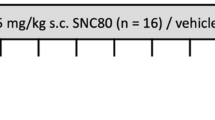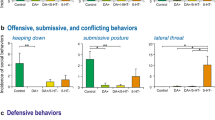Abstract
Exploratory behavior of a complex novel environment was examined 3 and 14 days following treatment with the noradrenergic-selective neurotoxin, DSP-4. This toxin significantly decreased norepinephrine concentrations in neocortex and hippocampus but not hypothalamus. DSP-4 significantly increased exploratory behavior in animals tested 3 days after treatment. In contrast, exploratory behavior was decreased in animals tested 14 days after treatment. The effect of DSP-4 at 3 days is similar to treatments that act to inhibit noradrenergic function such as administration of the α1-antagonist, prazosin, or the α2-agonist, clonidine. The effect of DSP-4 at 14 days resembles that observed following treatment with the α1-agonist, phenylephrine, or the α2-antagonist, idazoxan. These data provide additional support for a role of noradrenergic systems in exploratory behavior. The simplest explanation for the time dependent effects of DSP-4 on exploratory behavior is the occurrence of the slow development of a supersensitivity of cerebral systems affected by norepinephrine.
Similar content being viewed by others
References
Arnsten AFT, Segal DS (1979) Naloxone alters locomotion and interaction with environmental stimuli. Life Sci 25:1035–1042
Arnsten AFT, Segal DS, Loughlin SE, Roberts DCS (1981) Evidence for an interaction of opioid and noradrenergic locus coeruleus systems in the regulation of environmental stimulus-directed behavior. Brain Res 222:351–363
Arnsten AFT, Berridge CW, Segal DS (1985) Stress produces opioid-like effects on investigatory behavior. Pharmacol Biochem Behav 22:803–809
Benkirane S, Arbilla S, Langer SZ (1985) Supersensitivity of α2-adrenoceptors modulating [3H]5-HT release after noradrenergic denervation with DSP4. Eur J Pharmacol 119:131–133
Berridge CW, Dunn AJ (1986) Corticotropin-releasing factor elicits naloxone-sensitive stress-like alterations in exploratory behavior in mice. Regul Pept 16:83–93
Berridge CW, Dunn AJ (1987) α2-Noradrenergic agonists and antagonists alter exploratory behavior in mice. Neurosci Res Commun 1:97–103
Berridge CW, Dunn AJ (1989) Restraint-stress-induced changes in exploratory behavior appear to be mediated by norepinephrine-stimulated release of CRF. J Neurosci 9:3513–3521
Diaz J, Elison G, Masouka D (1978) Stages of recovery from central norepinephrine lesions in enriched and impoverished environments: a behavioral and biochemical study. Exp Brain Res 31:117–130
Dismukes RK, Ghosh P, Creveling CR, Daly JW (1975) Altered responsiveness of adenosine 3′,5′-monophosphate-generating systems in rat cortical slices after lesions of the medial forebrain bundle. Exp Neurol 49:725–735
Dolphin A, Adrien J, Hanon M, Bockaert J (1979) Identity of [3H]dihydroalprenolol binding sites and beta-adrenergic receptor coupled with adenylate cyclase in the central nervous system: pharmacological properties, distribution and adaptive responsiveness. Mol Pharmacol 15:1–15
Dooley DJ, Mogilnicka E, Delini-Stula A, Waechter F, Truog A, Wood J (1983) Functional supersensitivity to adrenergic agonists in the rat after DSP-4, a selective noradrenergic neurotoxin. Psychopharmacology 81:1–5
Dunn AJ (1988) Stress-related changes in cerebral catecholamine and indoleamine metabolism: lack of effect of adrenalectomy and corticosterone. J Neurochem 51:406–412
Hallman H, Jonsson G (1984) Pharmacological modifications of the neurotoxic action of the noradrenaline neurotoxin DSP-4 on central noradrenaline neurons. Eur J Pharmacol 103:269–278
Harik JL (1984) Coeruleus lesion by local 6-hydroxydopamine infusion causes marked and specific destruction of noradrenergic neurons, long-term depletion of and enhanced dopaminergic mechanisms in the ipsilateral cerebral cortex. J Neurosci 4:699–707
Harik SI, Duckrow RB, LaManna JC, Rosenthal M, Sharma VK, Banerjee SP (1981) Cerebral compensation for chronic noradrenergic denervation induced by locus ceruleus lesion: recovery of receptor binding, isoproterenol-induced adenylate cyclase activity, and oxidative metabolism. J Neurosci 1:641–649
Logue MP, Growdon JH, Coviella ILG, Wurtman RJ (1985) Differential effects of DSP-4 administration on regional brain norepinephrine turnover in rats. Life Sci 37:403–409
Mogilnicka E (1986) Increase inβ- and α1-adrenoceptor binding sites in the rat brain and in the α1-adrenoceptor functional sensitivity after the DSP-4-induced noradrenergic denervation. Pharmacol Biochem Behav 25:743–746
Sara SJ (1985) The locus coeruleus and cognitive function: attempts to relate noradrenergic enhancement of signal/noise in the brain to behavior. Physiol Psychol 13:151–162
Skolnick P, Stalvey LP, Daly JW, Hoyler E, Davis JN (1978) Binding of alpha and beta adrenergic ligands to cerebral cortical membranes. Effect of 6-hydroxydopamine treatment and relationship to the responsiveness of cyclic AMP generating systems in two rat strains. Eur J Pharmacol 47:201–210
Sporn JR, Wolfe BB, Harden TK, Kendall T, Molinoff PB (1977) Supersensitivity in rat cerebral cortex: pre- and post-synaptic effects of 6-hydroxydopamine at noradrenergic synapses. Mol Pharmacol 13:1170–1180
U'Prichard DC, Kvetnansky R (1980) Central and peripheral adrenergic receptors in acute and repeated immobilization stress. In: Usdin E, Kvetnansky R, Kopin I (eds) Catecholamines and stress: recent advances. Elsevier/North Holland, New York pp 299–308
Author information
Authors and Affiliations
Rights and permissions
About this article
Cite this article
Berridge, C.W., Dunn, A.J. DSP-4-induced depletion of brain norepinephrine produces opposite effects on exploratory behavior 3 and 14 days after treatment. Psychopharmacology 100, 504–508 (1990). https://doi.org/10.1007/BF02244003
Received:
Revised:
Issue Date:
DOI: https://doi.org/10.1007/BF02244003




